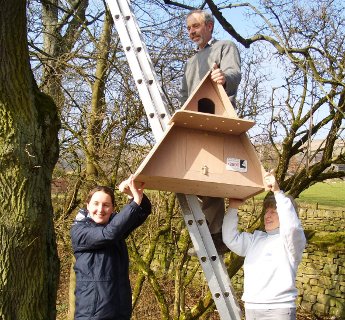NEW barn owl nest boxes have been installed today (Thursday) at Tunnel End Reservoir next to Standedge Tunnel on the Huddersfield Narrow Canal in a bid to help the plight of this threatened bird and help them flourish in some canal side homes.
 This is thanks to a £1,000 grant from The Waterway Trust's Small Grants scheme, with the nesting boxes, suitable for owls and kestrels, installed by the Wildlife Conservation Partnership in collaboration with British Waterways.
This is thanks to a £1,000 grant from The Waterway Trust's Small Grants scheme, with the nesting boxes, suitable for owls and kestrels, installed by the Wildlife Conservation Partnership in collaboration with British Waterways.
In the picture can be seen Phillippa Baron (dark blue jacket) Senior Ecologist for British Waterways along with Colin and Val Shawyer from the Wildlife Conservation Partnership.
Specifically designed
The specifically designed A-frame nesting boxes will be located in a number of trees around the reservoir, where the habitat is strong enough to support the birds.
Phillippa explained:
"This is a fantastic scheme which we hope in time will encourage the birds to nest and help preserve their population. It is thanks to funding and cooperation with partner organisations and individuals that this type of project is possible.
"Owls face a number of threats including the cutting down of trees, the destruction of natural grasslands and barn conversions, so it's really important we do what we can to protect them. The waterways are home to many protected species and they provide an ideal home and feeding ground."
Protected species
As barn owls are a protected species (Wildlife and Countryside Act), British Waterways work alongside The Wildlife Conservation Partnership to carry out the annual maintenance and monitoring. They are licenced to handle the owls and ring them so biodiversity specialists can better understand the process by which the owl population is recovering.
A similar scheme was most successful along the Aire & Calder Navigation which began 10 years ago with 30 barn owl boxes installed along the canal. During their annual inspections last year, five separate broods were found nesting.
